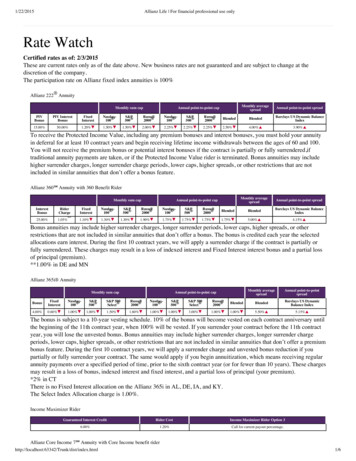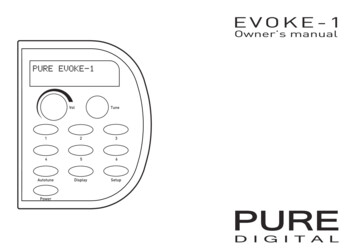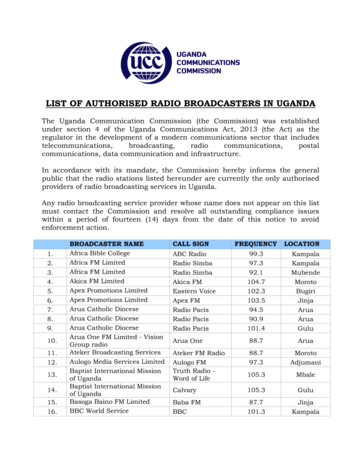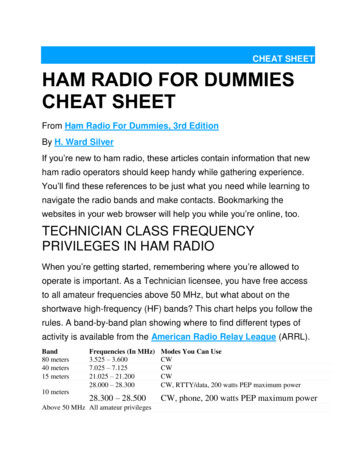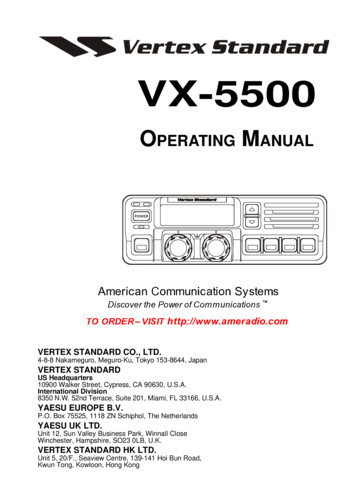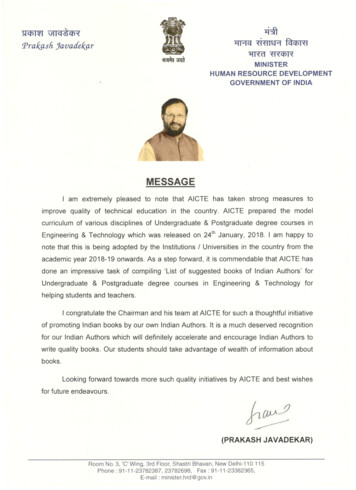
Transcription
No1701basicelectronicsby VAN VALKENBURGH,NOOGER & NEVILLE, INC.VOL. 1INTRODUCTION TO ELECTRONICSDIODE VACUUM TUBES,DRY METAL RECTIFIERSWHAT A POWER SUPPLY ISFILTERS, VOLTAGE REGULATORSa RI DE R publication
2.25basicelectronicsby VAN VALKENBURGH,NOOGER & NEVILLE, INC.VOL. 1JO H N116WestF.RI DE R14thStreetPU BLI S HE R, Ne w York11,IN C.N.Y.
First EditionCopyright 1935 byVAN VALKENBURGH, NOOGER AND NEVILLE,INC.All Rights Reserved under International and PanAmerican Conventions. This book or parts thereofmay not he reproduced in any form or in anylanguage without permission of the copyright owner.Library of Congress Catalog Card No. 55-6984Printed in the United Statesof America
PREF ACEThe texts of the entire Basic Electricity and Basic Electronicscourses, ascurrently taught at Navy specialty schools, have now beenreleased by the Navy for civilian use. This educational programhas been an unqualified success. Since April, 1953, when itwas firstinstalled, over 25,000 Navy trainees have benefited by this instruction and the results have been outstanding.The unique simplification of an ordinarily complex subject, theexceptional clarity of ilustrations and text, and the plan of presenting one basic concept at atime, without involving complicatedmathematics, all combine in making this course abetter and quickerway to teach and learn basic electricity and electronics.Inreleasing this material tothe general public, the Navy hopes toprovide the means for creating a nation-wide pool of pretrainedtechnicians, upon whom the Armed Forces could call in time ofnational emergency, without the need forprecious weeksand monthsof schooling.Perhaps of greater importance isthe Navy's hope that throughthe release of this course, adirect contribution will be made towardincreasing the technical knowledge of men and women throughoutthe country, as astep in making and keeping America strong.Van Valkenburgh, Nooger and Neville,Inc.New York,N. Y.February, 1955111
TABLEOFCO NTE NT SVOL. 1— BASIC ELECTRONICSIntroduction to Electronics11What aPower Supply Is17Half- Wave Rectifiers—Dry Metal Type117Half- Wave Rectifiers—Vacuum Tube Type123Half- Wave Rectifiers —Transformer Type139The Full- Wave Rectifier Circuit145Filter Circuits152Voltage Regulator Circuits181Other Types of Power Supply Circuits192Characteristics of Diode Vacuum Tubes1109V
itett4oreacteog toAIMACOPIOCWhat You Are Going To Do NowYou now have a good solid foundationin the field of electricity. You knowhow electricity is generated, howelectron current flows through a circuit, the nature and uses of magnetism, the proper use and care ofmeters, the characteristics of DCand AC and how various types ofelectrical motors and other electrical devices operate.DC & ACMachineryNow you have all the funda mentalknowledge that you need to beginyour study of anew and fascinatingsubject —electronics.AC CircuitsDC Circuitsvii
git6pArtriefi'en f2ekehc/iik4
INTRODUCTION TO ELECTRONICSThe Meaning of "Electronics"You have heard the word "electronics" many times in the past. Electronics means the science of the electron. Since the study of electricityand electronics both involve the use of the concept of electron flow, youmay wonder where electricity ends and electronics begins. For your purposes itis easy enough to make the distinction that electronics is thescience which is concerned with the flow of electrons through vacuum orgas-filled tubes someti mes called "electron tubes." Thus, electronicsincludes the study of any equip ment that contains "tubes."You are already acquainted with quite a few types of electronic equip ment.Radio —"talkie" motion pictures —record players —public address syste ms—television —"electric eye" door openers —all of these make use of "tubes"and are correctly ter med electronic equip ment. Of course they also makeuse of various types of DC and AC circuits, of meters, transfor mers, capacitors, and all the other co mponents which you have learned about inBasic Electricity. That is why you needed a course in fundamentals before going on with the electronics phase of your study.moviesBrought To Yo1-1
INTRODUCTION TO ELECTRONICSElectronic Equip mentAll electronic equipment is made up of only a few basic circuits. Just howmany basic types of circuit are there? Three! Are there any other typesyou will ever have to know? There are additional types of special circuitsyou will have to learn when you begin to study equipment, but these specialcircuits are nothing but variations of the three basic electronic circuits.The three basic electronic circuits are rectifier circuits, amplifier circuits and oscillator circuits.Rectifier circuits change AC to DC.Their most com mon use is in electronic equip ment power supplieswhich take AC from the power lineand transfor m itto DC which is required to operate electron tubes.Amplifier circuits take small voltage changes and enlarge or amplifythe m into large voltage changes.Amplifier circuits are by far themost co mmonly used circuits inelectronic equipment. They takevery weak signals that are barelydetectable and amplify the m intostrong signals that can drive apair of earphones, aloudspeakeror an oscilloscope.Oscillator circuits generate ACvoltages at any particular desiredfrequency. Oscillator circuits areused to generate the AC voltagesthat carry a radio signal from oneplace to another. They are alsoused very extensively for testingother electronic circuits.1-2
INTRODUCTION TO ELECTRONICSParts Used in Electronic EquipmentNow that you have found out that there are only three basic types of electronic circuits (rectifiers, amplifiers and oscillators)that you have to beconcerned with, you probably would like to know about the parts used inthose circuits. Actually there are only six co m monly used types of partsin electronic circuits. Five of these parts you already know —resistors,capacitors, coils, transformers and switches. There is one additionaltype of part that you will learn about very soon —"vacuum tubes."You see that by understanding three basic types of electronic circuits andthe use of six types of parts in those circuits, you will understand all youneed to know about electronics for the present.tom duel ad dueaire cerzaerd mode,„.II-.-100000‘- CAPACITORCOIL UUM TUBE
WHAT A PO WER SUPPLY ISImportance of Power SuppliesEverything that lives or does work must have a source of power or a"power supply." The sun supplies power that enables plants to manufacture food, and food in turn supplies the power that makes you live andmove, -speak, run, and think. In the realm of nonliving mechanisms,the motor in the old Model "T" supplied power to move the car as surelyas the huge turbines at Boulder Dam supply power today to drive electric generators.Itis obvious that the same kind of power is not used in the same way inthese different cases. Each thing —large or small, living or nonliving —must take its power from a primary source such as the sun, falling water,or an electric light socket and change itinto the specific kind of powerneeded. In electronics, then, a"power supply" is acircuit or device thatchanges the primary electric power into the kind and amount of AC or DCneeded by different types of electronic circuits.1-7
WHAT A PO WER SUPPLY ISWhat Power Supplies DoLet's get down to cases and find out just what apower supply is supposedto do. Different types of electronic equipment —amplifiers, oscillators,trans mitters and receivers —contain different types of vacuum tube circuits which must have certain AC and DC voltages supplied to the m beforethey can operate. While there are exceptions, in general these variousvacuum tube circuits require approximately 350 volts DC and 6.3 voltsAC. Just why these two voltages are required is something you will learnwhen you come to study these circuits. For the present itis enough foryou to know that the usual power supply must put out these voltages.When you plug any piece of electronic equipment into an electric outlet,that outlet puts out 17 volts AC. That is not what you want —the vacuumtube circuits usually must have 350 volts DC and 6.3 volts AC. How apower supply changes the available line voltage into the high DC voltage(called "B " voltage in all electronics work) and low AC voltage is themajor subject of this section.,.,----Teuit aetfitccal thdeit e? deeAfe4350 0(4 De,e6.3 egaled eewe Tfuer oar,aw,i-1-8
WHAT A PO WER SUPPLY ISHow a Power Supply Works —The Transfor merA typical power supply consists of three major components —a transfor mer, arectifier and a filter.You already know about transfor mers from your work in basic electricity.Atransfor mer is adevice made up of two or more coils of wire wound onan iron core. Transfor mers can take an AC voltage and increase itor decrease itdepending upon the number of turns of wire in the various windings. Here are a few examples of transfor mers that you will find in electronic equip ment power supplies.In atypical power supply the transfor mer is connected to the 117-volt ACpower line through a suitable fuse and switch. The transfor mer puts outthree AC voltages —a voltage somewhat higher than 350 volts AC, 5voltsAC and 6.3 volts AC. The 6.3 volt AC output is connected directly to thevacuu m tube circuits. The other two voltages are connected to the rectifier circuit where the high voltage AC is changed to approximately 350volts DC. More than 350 volts AC are required to get 350 volts DC because of losses that occur in the process of changing AC to DC, so youmust begin with a higher voltage than you want to take out.Over 350 volts ACto Rectifier- PTo Rectifierto be changedto approxi mately350 volts DC5volts ACto Rectifier1-96.3 volts ACto vacuum tube
WHAT A PO WER SUPPLY ISHow a Power Supply Works —The RectifierUp to now you have learned that the job of atypical power supply is to take17 volts AC from the power line and to put out approxi mately 350 voltsDC and 6.3 volts AC. You have learned that the major components of apower supply are a transfor mer, arectifier and a filter circuit; and youhave found out about the job of the transfor mer.The job of the rectifier is to change the high voltage AC coming out of thetransfor mer into high voltage DC. The 5-volt AC voltage coming out ofthe transfor mer is used to heat the rectifier tube, when such a type of rectifier is used. The 5-volt AC winding is eliminated from the transfor merwhen itis not required for the operation of the rectifier.The job of changing high voltage AC into high voltage DC is adifficult one.All the rectifier can do is to change the AC into pulsating DC like this:H A L F- W A V ER E C TI FI C A TI O N0V.0ra.- INPUT-E OUTPUT —F U L L- W A V EV. --R E C TI F I C A TI O N0V0VM EMINPUT OUTPUT7"--Notice that the DC output is not aconstant voltage but rises and falls intime with the AC voltage input. When only the positive half cycles of theinput voltage are allowed to pass through the rectifier and the negativehalf cycles cannot pass through at all, the process is called "half-waverectification."When the positive half cycle of the input voltage is allowed to pass throughthe rectifier and the negative half cycles are changed to positive halfcycles, the process is called "full-wave rectification."1-10
WHAT A POWER SUPPLY ISHow a Power Supply Works —The Rectifier (continued)The rectifiers you will work with in this section will be dry metal orvacuu m tube rectifiers. Either of these rectifiers come in half-wave orfull-wave types. Vacuum tube rectifiers require that the transfor merhave a low voltage AC winding which supplies the rectifier tube withheater voltage. Dry metal rectifiers do not require this winding.0.01FIERsH A L F-14AV ER EC T I F I C A T I O NF I. L I.- WAV ER EC T I F I C A T IO N
WHAT A PO WER SUPPLY ISHow a Power Supply Works —The FilterSo far you have learned that the job of atypical power supply is to take17 volts AC from the power line and to deliver approxi mately 350 voltsDC and 6.3 volts AC. You have learned that the major components of apower supply are a transfor mer, arectifier and a filter circuit. You havelearned the purpose of the transfor mer and the rectifier, and now you areready to learn about the filter.You know that the output of the rectifier is apulsating DC voltage. Whatyou want is asteady DC voltage of 350 volts with as little pulsation aspossible.4-Voltage Outputkibt our 1ov—iBut1theRectifiergivesyou . . . .1,The job of the filter circuit is to smooth out the pulsations in the rectifieroutput and give you a steady voltage with little or no ripple. Filter circuits come in various for ms, but all filter circuits are made up of variouscombinations of inductances and capacitors or resistances and capacitors.You will learn how these filter circuits work to smooth out the pulsationsin the rectifier output as soon as you have done some work with variousrectifier circuits.AA A4FILTERCIRCUITFILTERCIRCUITTYPICALCIRCUITS1-12 0V-- ."---.0,- --10
WHAT A PO WER SUPPLY ISVoltage RegulatorsAtypical power supply is made up of atransfor mer, arectifier and a filter circuit. This is all that is required to give you the high voltage DCand the low voltage AC required to operate various types of electronic circuits. However, when "urrent is drawn out of the high voltage DC ter minal of apower supply, the voltage drops. This is due to the internal resistance of the power supply. Itis not unusual for the 350-volt DC outputto drop to 300 volts when the current drawn out increases from 0.05 ampto 0.100 amp.This voltage drop is not serious for many types of electronic circuits, andthey will go right on working in the proper manner. However, there aresome types of electronic circuits that cannot operate properly ifthe voltage varies more than two or three volts. These types of circuits requirethat the power supply have a voltage regulator circuit added to it. When apower supply has a voltage regulator circuit, only those circuits that require a constant voltage are connected to the voltage regulator —other circuits are usually connected directly to the unregulated high voltage DCter minal.The basic part of all voltage regulator circuits is the voltage regulatortube, com monly known as the "VR" tube. These tubes are made so thatthey will hold the DC voltage at aparticular point in spite of current variations. VR tubes are made so that they will hold the voltage at 59, 75, 90,108, and 153 volts DC. By using various combinations of these tubes, youcan get aconstant voltage of al most any value that is required.TUBES1-13
WHAT A PO WER SUPPLY ISWhy There are Different Types of Power SuppliesYou know that most power supplies are made up of transfor mers, rectifiers, filter circuits and someti mes voltage regulators. You can get almost any kind of power supply by putting these components together invarious ways. Of course, so meti mes you will have to use large rectifiertubes and large transfor mers; so meti mes you will have to use sub- miniatureparts; but, large or small, all the circuits will contain the same components.Whether large orsmall, use standardcircuits1-14
WHAT A PO WER SUPPLY ISWhy There are Different Types of Power Supplies (continued)Now you will want to know why there are different types of power suppliesused in various types of equip ment. After all, the major job they do isnothing more than changing AC into DC.0V—AC inTYPICALPO WERJSUPPLY1 110DC outThe reason why different types of power supplies are required is si mple.One power supply you may build would go up in smoke ifyou drew muchmore than 150 ma. of current from the high DC voltage supply. Certaintypes of trans mitters require as much as 5,000 or 10,000 ma. fro m theirpower supplies. Certain special oscilloscope circuits may require a DCoutput of 10,000 volts or more.115
WHAT A PO WER SUPPLY ISWhy There are Different Types of Power Supplies (continued)Some special radar circuits require power supplies with especially goodvoltage regulation. This means that the DC voltage put out by the powersupply must not change more than one or two volts when the current isvarying.So meti mes power supplies are needed that will put out negative DC voltages rather than positive DC voltages. So meti mes power supplies areneeded that will put out several positive and several negative DC voltages.So meti mes a superlow ripple is required, etc. etc.From this, you can see that there are many jobs for power supplies.HIGH VOLTAGEHEAVY CURRENTSUPER-LO W RIPPLESPECIAL VOLTAGE REGULATIONVARIABLE VOLTAGE1-16
HALF-WAVE RECTIFIERS —DRY METAL TYPEChanging AC to DCMost electric power is distributed by AC power lines and most electronicequipments contain power supplies which change the AC power line voltageto those DC and AC voltages required by the equipment. To change theAC power line voltage to other AC voltages is relatively simple. Atransformer is used to either step up or step down the line voltage,to obtain therequired AC voltages.PO WER SUPPLY TRANSFORMERS STEP UP OR STEP DOWNVOLTAGES AS REQUIREDsecondary to raise voltageStep-UPStep-D0oWN Isecondary to lower voltageAC Power LineTo obtain the required DC voltages, the AC line voltage must be changedto DC. This changing of AC to DC is called "rectification." Devices whichchange AC to DC are called "rectifiers" and circuits used to change AC toDC are called "rectifier circuits."Rectifiers are devices which allow current to flow through them in onedirection only, acting as aconductor for current flow in one direction andas an insulator for current flow in the other direction. Thus when a rectifier is placed in an AC circuit every other hall-cycle of the AC voltagecauses current flow in the circuit in that direction for which the rectifieris aconductor. Since the alternate hall-cycles are. trying to force currentthrough the circuit in adirection for which the rectifier acts as an insulator, no current flows during these alternate hall-cycles. As a result, thecurrent flow in asimple rectifier circuit is pulsating DC (alternate halfcycles of AC) rather than a steady DC current CIRCUITInputARECTIFIERconducts in one direction.insulates in the other.1-17Output
HALF- WAVE RECTIFIERS —DRY METAL TYPEDry Metal RectifiersWhen certain metallic materials are pressed together to for m a junction,the co mbination acts as arectifier having a low resistance to current flowin one direction and a very high resistance to current flow in the oppositedirection. This action is due to the che mical properties of the co mbinedmaterials. The co mbinations usually used as rectifiers are copper andcopper-oxide, or iron and seleniu m. Dry metal rectifiers are constructedof disks ranging in size fro m less than a half inch to more than six inchesin dia meter. Copper-oxide rectifiers consist of disks of copper coated onone side with a layer of copper oxide while seleniu m rectifiers are constructed of iron disks coated on one side with selenium.DRY METALRECTIFIERS!CopperNms,IronCopper OxideCoatingSeleniu mCoatingCOPPER OXIDERECTIFIERSELENIU MRECTIFIERDry metal rectifier ele ments (an ele ment is asingle disk) are generallymade in the for m of washers which are asse mbled on a mounting bolt inany desired series or parallel co mbination to for m a rectifier unit. Thesy mbol shown below is used to represent adry metal rectifier of any type.Since these rectifiers were made before the electron theory was used todeter mine the direction of current flow, the arrow points in the directionof conventional current flow but in the direction opposite to the electronflow. Thus the arrow points inopposite direction tothat of the currentflowas used in electronics.DRY METAL RECTIFIER SYMBOLELECTRONcurrent flowopposite direction fro m sy mbol arrow118
HALF- WAVE RECTIFIERS —DRY METAL TYPEDry Metal Rectifiers (continued)Each dry metal rectifier ele ment will stand only a few volts across itster minals but by stacking several ele ments in series the voltage rating isincreased. Similarly each ele ment can pass only a limited amount of current. When greater current is desired several series stacks are connected in parallel to provide the desired amount of current.actied, atadeig9 ege reetde4 riteWI WI" RAT/NO 4a dizzy metal owe-qt.:etRectifier Ele mentMetal SpacerAetna/tee coggettioo egeiteade4CURRENT RAT/NO.IC/CONNECT ELE MENTSIN PARALLELINCREASING PLATEAREADry metal rectifiers are very rugged and have an al most unlimited life ifnot abused. Because of the low voltage rating of individual units they arenor mally used for low voltages (130 volts or less) since itbeco mes impractical to connect too many ele ments in series. By paralleling stacksor increasing the dia meter of the disks, the current rating can be increased to several amperes so that they are often used for low voltagehigh current applications. Very small units are used to measure AC voltage on a DC volt meter. Larger units are used in battery chargers andvarious types of power supplies for electronic equipment.1-19
HALF-WAVE RECTIFIERS —DRY METAL TYPEDry Metal Rectifiers (continued)Selenium rectifiers are used in power supplies while copper oxide rectifiers are used in special applications such as meter rectifiers. Atypicalselenium rectifier of the type used in practical power supplies is illustrated below. It is rated at 130 volts AC and can furnish a maximum of100 ma. of DC current. The terminal marking indicates the polarity ofthe rectifier and is used for identification of leads when connecting therectifier in acircuit. The positive terminal is sometimes identified by ared dot and the negative ter minal by ayellow dot.RECTIFIERDot markingRectifier disksTerminal markingRadiation platesUSED IN POWER SUPPLIESA perfect rectifier would offer no resistance to current flow in one direction and infinite resistance in the opposite direction, but such a rectifieris only theoretical. Practical rectifiers used in power supplies actuallyhave low resistance in one direction and very high resistance in the opposite direction. For dry metal rectifiers these resistances can be measured with an ohmmeter.To test aselenium rectifier the resistance across the ter minals is measured in one direction, and then the ohm meter leads are reversed to measure the resistance in the opposite direction. Ifthe high reading is 10 ormore times as large as the low reading, the rectifier is in good condition.1-20
HALF- WAVE RECTIFIERS —DRY METAL TYPEAHalf-Wave Rectifier CircuitA basic half-wave rectifier circuit consists of arectifier connected inseries between the AC voltage source and the circuit load resistance. Therectifier per mits current to flow only during the positive hall cycles of theapplied AC voltage and the circuit current then is pulsating DC. In the circuit illustrated,the applied line voltage is 17 volts,60 cycles AC and current flows only for one half of each cycle. Thus the current flow throughthe circuit is in pulses at the rate of 60 pulses per second. Actually thereis aslight current flow in the opposite direction during the negative halfcycles but itis so small that itis considered to be zero.This si mple circuit ilustrated is the basic circuit used to change AC toDC. When connected as shown, the DC voltage across the load resistor ispositive at the end which connects to the rectifier and negative at the otherend. The negative ter minal of the load resistor is nor mally grounded tothe chassis in apower supply.HALF- WAVE RECTIFIER CIRCUIT-To reverse the polarity of the DC voltage obtained,the rectifier isreversed.This allows current to flow only on the opposite half cycles as comparedtothe previous circuit. This circuit is used to obtain a negative DC voltagewith respect to ground. The grounded end of the load resistor is positive.REVERSING THE POLARITY OFOUTPUT VOLTAGENote that the rectifierhas been reversed1-21
HALF-WAVE RECTIFIERS —DRy METAL TYPEReviewRECTIFICATION — Whena devicecalled a rectifier is placed in serieswith an AC circuit, itpermits currentto flow only in one direction, changingthe applied AC voltage to pulsating DC.Rectification is the changing of ACto DC.ACHALF- WAVERECTIFIERCIRCUITInputDCAOutputDRY METAL RECTIFIEFtS — A rectifier consisting of two unlike metallicsubstances pressed together, whichallows current flow in one directiononly. Copper-oxide and iron-seleniumcombinations are usually used to construct dry metal rectifiers.Cop per-oxideIron-seleniumHALF- WAVE RECTIFIER CIRCU IT —A rectifier connected inseries betweenan AC voltage source and the circuitload resistance. The rectifier changesthe applied AC to a DC output voltageacross the load resistance.RECTIFIER CIRCUIT WAVEFORMS —If the applied voltage is an AC sinewave, the output waveform consistsof half cycles of the applied AC voltage. This output waveform is a pulsating DC voltage.Applied ACVoltage&AInput1-22PulsatingDC VoltageOutput
HALF- WAVE RECTIFIERS —VACUU M TUBE TYPEVacuum TubesDry metal rectifiers are used in many power supplies to change AC toDC but they are limited as to voltage and current rating. They are notnormally rated at voltages greater than 130 volts AC. Low voltage unitsrated at 10 volts or less have a high current capacity, greater than 1ampere, while the current capacity of higher voltage units is much lessthan 1ampere.Because of the voltage and current limitations of dry metal rectifiers, another type of rectifier, the diode vacuum tube, is often used in power supplies. As a rectifier, the diode vacuum tube operates in the sa me way asadry metal rectifier, acting as agood conductor of current in one direction and as an insulator in the other direction. The diode vacuum tube alsohas many other uses in electronics which you will find out about later.VACUU M TUBE RECTIFIERSDO THE SA ME JOB ASDRY METAL RECTIFIERS1-23
HALF- WAVE RECTIFIERS —VACUU M TUBE TYPEThe Discovery of the DiodeThe principle on which a diode is based was discovered so me 70 years ago—before anything was known about electrons.Tho mas Edison was working on an experi ment with his incandescent la mpsin which a carbon fila ment was used. The fila ments which he used broketoo easily as they were constructed of thin threads or fila ments of carbon. WHENCURRENTFLO WSINTHE FILA MENT, IT BECO MESWHITE HOT AND LIGHT IS RA DIATED FRO M IT.In an effort to lengthen the life of his light bulbs, Edison constructed ametal support which he connected to the fragile fila ment by insulated sections. For so me unknown reason, he connected the metal support to thepositive side of abattery and the fila ment to the negative side. To hissurprise, he noticed that acurrent was flowing.:THE METER SHOWSTHATCURRENTISFLO WING FRO M THEFILA MENTTOTHEMETAL SUPPORT.Since nothing was known about electrons, Edison could not understand orsee any importance in his discovery and ittook 21 years before Fle ming,a British scientist learned the significance of this flow of electrons. Because he observed that current could flow only in one direction, Fle mingcalled his vacuum tube a "valve." In fact, vacuu m tubes are still called"valves" by the British.1-24
HALF- WAVE RECTIFIERS —VACUU M TUBE TYPEHow a Diode Tube WorksThe diode vacuu m tube is like a ga me of baseball in which control is theimportant thing. An understanding of how a diode vacuum tube controlsthe flow of current is required to understand how a diode tube worksas arectifier.The parts of avacuum tube which directly control the flow of current arecalled ele ments. A heated ele ment which gives up electrons is called thecathode. The plate is acylindrical ele ment surrounding the cathode whichattracts electrons when it is positively charged. The cathode is heatedby afila ment of resistance wire called a heater, which is not consideredto be an ele ment since itdoes not directly control the amount of currentflow fro m cathode to plate. A vacuu m tube of the type illustrated is calledadiode because ithas only two ele ments, acathode and plate.In addition to preventing the fila ment fro m burning, re moving the air fro mthe tube prevents the air molecules fro m interfering with the flow ofelectrons fro m cathode to plate. So meti mes the air is replaced by aninert gas which aids rather than opposes the electron flow.1-25
HALF- WAVE RECTIFIERS —VACUU M TUBE TYPEElectron EmissionThe basic require ment of adiode vacuu m tube is that there has to be asource of freely moving electrons which can be used to give us currentflow. Of course, electrons are found in every ato m of every substancebut we still need a method of driving the m out of the substance to makethe m freely moving.In Edison's set-up, the intense heat of the filament did the trick, andheat is used to do itin practically all the vacuum tubes you will see.Driving electrons out of asubstance by heat is known as "ther mionicemission."In the illustration, you will notice that the cathode is acylinder or"sleeve" which surrounds, but does not touch, the fila ment. The fila mentis heated by the current flowing in itand the cathode is heated because itis so close to the fila ment. This arrange ment of parts is known as an indirectly heated cathode.ELECTRONFILA MENTCATHODETHER MI ONICEMISSI ON111 111So me tubes such as the Fle ming's Valve or the type 80 rectifier tube havewhat is known as directly heated cathodes, which means that there is nosleeve around the fila ment and the fila ment is itself the electron emitter.CATHODEFILA MENTINDIRECTLY HEATEDDIRECTLY HEATEDBecause they can emit many more electrons than the indirectly heatedtype,directly heated cathodes are used in vacuu m tubes designed for power supplies which supply high currents. Indirectly heated cathodes aremore frequently used in low-current power supplies. Having the heater(fila ment) and the electron emitter (cathode) separate in a
circuits are nothing but variations of the three basic electronic circuits. The three basic electronic circuits are rectifier circuits, amplifier cir-cuits and oscillator circuits. Rectifier circuits change AC to DC. Their most common use is in elec-tronic equipment power supplies which tak
